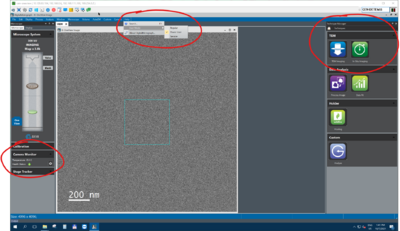LabAdviser/314/Microscopy 314-307/TEM/ETEM/OneView: Difference between revisions
| Line 22: | Line 22: | ||
- drift correction available<br /> | - drift correction available<br /> | ||
- In ''in situ'' mode: look back option available up to 30s<br /> | - In ''in situ'' mode: look back option available up to 30s<br /> | ||
- In our setup, the OneView camera exclusively uses the pre-specimen shutter in idle state (beam on the camera but camera not running).<br /> | - In our setup, the OneView camera exclusively uses the pre-specimen shutter in idle state (beam on the camera but camera not running), which means the sample is not illuminated.<br /> | ||
<br /> | <br /> | ||
Revision as of 13:43, 7 October 2021
Feedback to this page: click here
(content by Jens Kling, September 2021)
Gatan OneView camera and GMS3

Here are a few information on the OneView camera and the control in GMS3:
General info
- CMOS camera with 4096 x 4096px (pixel size: 15µm) --> 61.4 x 61.4mm sensor size; conversion efficiency @300kV: 26.42 ADC counts/Prim e- (our camera)
- Imaging mode: 25fps for full 4k x 4k resolution (single frame exposure time: 0.04s); 100fps @ 2k x 2k; 200fps @ 1k x 1k; 300fps @ 512 x 512
- Diffraction mode: about 7fps for full 4k x 4k (single frame exposure time: 0.16s)
- drift correction available
- In in situ mode: look back option available up to 30s
- In our setup, the OneView camera exclusively uses the pre-specimen shutter in idle state (beam on the camera but camera not running), which means the sample is not illuminated.
Operation
1. If GMS3 (Gatan Microscopy Suite; also known as Digital Micrograph) is not running on the separate computer (large screen) yet, click on the GMS icon and acknowledge any information message.
2. Check in the Camera Monitor that the temperature is -5°C. Else, wait until it reaches this temperature.
3. On the Microscope PC, the software Gatan Remote should be running in the background. If not, start this software.
4. Make sure you are an Power User. Click on Help in the top task bar and select Power User under User Mode. Now you have all relevant settings and properties available.
5. On the left hand side under Microscope, GMS shows the visualization of the TEM. Here, HT and Magnification should be the same as in the Microscope PC. Clicking on Valves will open or close the Column Valves, Blank will blank the beam before the sample, clicking on the Phosphorous screen will lift or lower the screen. Right click on the OneView camera icon opens a context menu, where the camera can be inserted or retracted.
!!! The Ultrascan camera needs to be retracted before inserting the OneView camera !!!
6. On the frontpage right hand side, you find the Technique Manager. Under TEM you find TEM imaging and In-situ imaging.
Image acquisition
1. Choose TEM imaging under Technique Manager for general image acquisition.
2. Options:
- I for imaging mode, D for diffraction mode; binning from 4096px down to 512px (when changing mode/binning, wait a minute for the electronics to stabilize again)
- Live and Capture to follow the sample on the camera and acquire individual images.
- The cogwheel icon opens additional options like auto save and how drift corrected images are handled.
- Correct Drift is the drift correction between individual frame acquisition. It adds a cyan window to the Live View window, which can be moved. Drift correction is based on this section of the image.
Imaging mode
- The camera is running on the maximum frame rate (minimum exposure time) for the selected binning. For 4k it means, each individual frame is acquired at about 0.04s (25fps).
- Changing the Exposure (no matter if in View of Capture mode) means, the camera acquires individual frames with the shortest possible exposure time, and sums them up until the selected exposure time is reached. So, it's not the "real" exposure time on the camera which is changed, but the number of individual frames in the summed image.
- Correct Drift aligns this stack of individual frames.
- This means the signal-to-noise in each individual frame should be high enough to get a decent summed final image.
Diffraction mode
- In diffraction mode, the minimum exposure time increase 4 times. For 4k this means to 0.16s.
- Increasing the exposure results in summing individual frames (as in imaging mode).
- As the minimum exposure time for the individual frame is 4x higher, the signal-to-noise in the individual frame is better compared to imaging mode. This can help for very low dose acquisition.
In Situ Imaging
1. Choose In Situ Imaging under Technique Manager for in situ image acquisition.
2. Options:
- Under In-Situ Acquisition there are the same options as in Image Acquisition for I, D and different binning.
- The cogwheel icon opens the options for:
- Frame Exposure/Frame Rate (they are linked together)
- Look-back Duration
- Folder Path to save the dataset
- Dataset Name
- Frame Exposure/Frame Rate (they are linked together)
- Look-back can be up to 30s. This means, when starting View the LookBack Buffer will fill up (indicated by the blue bar on the control panel). When clicking on Record the time in the LookBack Buffer will be added in front of the dataset. F.ex. when LookBack is 30s and the buffer is completely filled, the immediate 30s before clicking on Record will be added in front of the dataset.
- Exposure in In-Situ Acquisitions means "real" exposure time on the camera.
- Each frame will be saved hierarchically in the folder under Hour_xx, Minute_xx, Second_xx.
